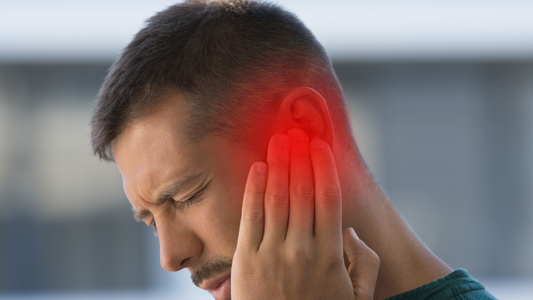Struggling with that persistent ringing in your ears when all you want is a moment of silence? There's a straightforward approach to lessen that annoyance. We’re talking about surrounding yourself with ordinary sounds—a fan humming or leaves rustling—to make that ringing less intrusive. Sounds too easy to be effective? But these everyday noises can be surprisingly helpful.
You could be holding the key to quieter days and nights right in your home. This isn't hocus-pocus; it's called sound therapy. Ever been so immersed in a good TV show that you didn't realize the buzz of the refrigerator? Sound therapy has a similar effect. Interested in tools that might just grant your ears that much-needed respite? I’ll show you how these devices work to improve your day-to-day quiet moments.
Exploring the Benefits of Sound Therapy
Struggling with that constant ringing in your ears? Consider this: you're sitting comfortably, and there's a calming sound in the background softening the tinnitus buzz. This is sound therapy. It employs a variety of sounds to minimize the disturbance of tinnitus and promote relaxation. Introducing consistent, pleasant noise helps your brain shift attention away from the tinnitus. It's like how you can get lost in a good book and tune out the noise around you. Sound therapy won't silence the ringing, but it can make it less intrusive. And the good news is, you might not need high-tech gadgets; even a steady hum of a fan might work wonders. Learn more about the impact of noise exposure on tinnitus.
White Noise Device Sounds
What kinds of sounds bring you a sense of calm? Maybe it's a gentle rain tapping the window or the quiet babble of a brook. These are the soothing experiences replicated by white noise devices, aimed at aiding those with tinnitus. They provide a variety of sounds that can mask the persistent symptoms of tinnitus, like that bothersome buzzing or whistling. White noise is the combination of all audible frequencies playing together at an equal level, acting as a sonic blanket that covers the disruptive sounds you wish to escape from. It's like a fresh layer of white paint over a stained wall, concealing the blemishes. If you recall how peaceful the sound of rainfall is, a white noise device can recreate that sanctuary for you, paving the way for comfort and a night of more restful sleep.
White Noise Devices for Tinnitus

Struggling with tinnitus during the night? A white noise device might be the solution you haven’t thought about yet. They’re like silent companions that push the persistent ringing or buzzing into the background. Think of a device that doesn’t spill secrets but plays a steady, comforting sound. You’ve got options ranging from simple machines that mimic a gentle fan to pillows that let you rest your head on a cloud of sound. Each device has its purpose: to mix in with your tinnitus and give you some peace. You can dial in the settings to match your preferences, whether you find solace in ocean waves or crave the stillness of a serene forest. It's like turning down the volume of your tinnitus. So, next time you’re preparing for bed, consider whether a white noise device could improve your sleep routine.
Find Peace with Sound Therapy
Had enough of being awake because of that non-stop ringing? You're not alone. Sound therapy might be what you need to replace that noise with something more pleasant. You might find yourself enjoying a good book again as the sound takes a backseat, just like with the hum of an old fan.
Let’s be clear, this isn't hocus pocus. We're talking devices that could help you manage tinnitus more easily. Ever think a little gadget could be as soothing as your favorite armchair? Well, it’s possible with technology from HearWell Group. Give them a whirl; they could be the ticket to quieter days and better nights.
Sources & References
- Baguley, D., McFerran, D., & Hall, D. (2013). Tinnitus. The Lancet, 382(9904), 1600-1607. https://www.thelancet.com/journals/lancet/article/PIIS0140-6736(13)60142-7/fulltext
- Bhatt, J. M., Lin, H. W., & Bhattacharyya, N. (2016). Prevalence, severity, exposures, and treatment patterns of tinnitus in the United States. JAMA Otolaryngology–Head & Neck Surgery, 142(10), 959-965. https://jamanetwork.com/journals/jamaotolaryngology/fullarticle/2533660
- Biswas, R., & Hall, D. A. (2022). Global prevalence and incidence of tinnitus: A systematic review and meta-analysis. JAMA Neurology, 79(8), 796-807. https://jamanetwork.com/journals/jamaneurology/fullarticle/2795168
- Langguth, B., Kreuzer, P. M., Kleinjung, T., & De Ridder, D. (2013). Tinnitus: causes and clinical management. The Lancet Neurology, 12(9), 920-930. https://www.thelancet.com/journals/laneur/article/PIIS1474-4422(13)70160-1/fulltext
- Tunkel, D. E., Bauer, C. A., Sun, G. H., Rosenfeld, R. M., Chandrasekhar, S. S., Cunningham Jr, E. R., ... & Whamond, E. J. (2014). Clinical practice guideline: tinnitus. Otolaryngology–Head and Neck Surgery, 151(2_suppl), S1-S40. https://journals.sagepub.com/doi/10.1177/0194599814545325
- Zenner, H. P., Delb, W., Kröner-Herwig, B., Jäger, B., Peroz, I., Hesse, G., ... & Langguth, B. (2017). A multidisciplinary systematic review of the treatment for chronic idiopathic tinnitus. European Archives of Oto-Rhino-Laryngology, 274(5), 2079-2091. https://link.springer.com/article/10.1007/s00405-016-4401-y

The Hear Well Group Research Team: Trusted Hearing Health Insights
Our experienced research team compiles hearing health data from credible, peer-reviewed sources and presents it in easy-to-understand terminology. We ensure accuracy and trustworthiness, providing up-to-date, evidence-based recommendations to enhance hearing care practices and inform our readers' hearing well-being decisions.


